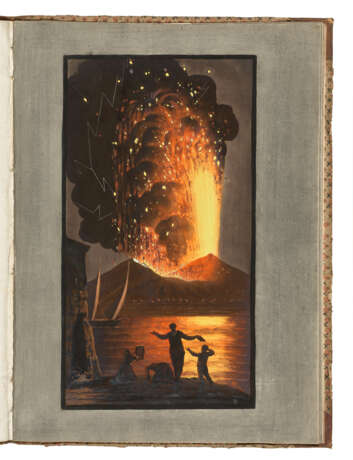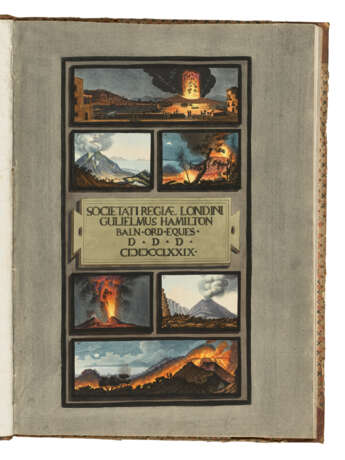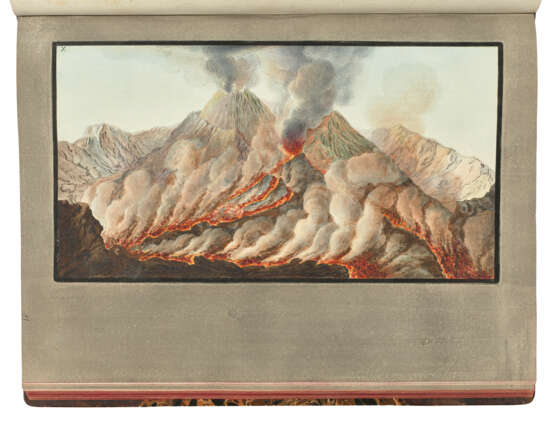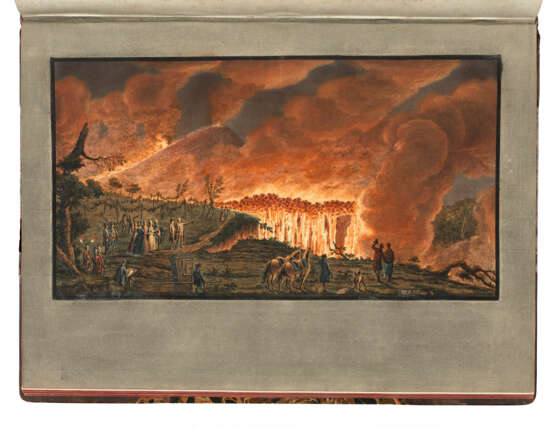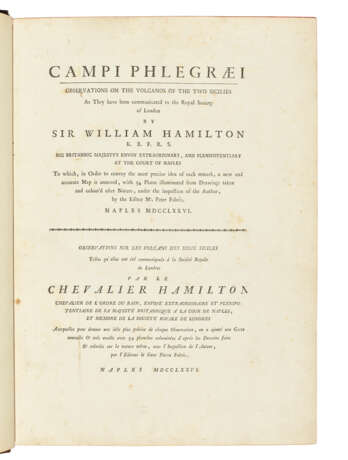ID 1450484
Lot 110 | HAMILTON, Sir William (1730-1803)
Valeur estimée
£ 30 000 – 50 000
Campi Phlegraei. Observations on the Volcanos of the Two Sicilies. Naples: [Pietro Fabris,] 1776-1779.
First edition, complete with the supplement, of Hamilton's ‘superbly illustrated work on the volcanic region around Naples’ (Rudwick).
Hamilton was the 'outstanding scientific authority' of the region and the Campi Phlegraei is the best known of his four works on volcanic activity. As English ambassador to the Kingdom of Naples from 1764 to 1800, Hamilton became captivated by the grandeur of Vesuvius; he collected specimens, led tours, and devoted himself to the scientific study and appreciation of the volcano. The present work is the result of his desire to give the public a taste of his experience. As he writes in the introduction, ‘I flatter myself at least by these exact representations of so many beautifull scenes, all of which have been undoubtedly produced by the explosions of volcanos, that this tremendous operation of nature will now be consider’d in a creative rather than a destructive light.’ The Campi Phlegraei ‘provided a clearer, more precise and useful explanation of volcanic activity than ever published before’ (Jenkin and Sloan).
The work’s remarkable hand-coloured plates, after the work of artist Peter Fabris and executed under the watchful eye of Hamilton himself, depict the changing rim of the erupting Vesuvius, as well as other volcanoes in the region, lava samples, and dramatic views of the country. Hamilton chose Fabris after the artist had accompanied him on a trip to Sicily in 1768, believing him to be uniquely capable of capturing the volcanic effects with the perfect balance of accuracy and beauty. Within four years he ascended Vesuvius twenty-two times, sometimes at great risk, since both he and Fabris wished to make sketches at every stage of the eruptions. The plates often depict Hamilton and Fabris, in red and blue coats respectively, moving through the landscape together. Campi Phlegraei did a great deal to cement the romance of the volcano in popular culture, and to promote Vesuvius as a major destination during the grand tour (ODNB). Brunet III, 31; ESTC T71231 (parts I-II); I. Jenkins & K. Sloan, Vases and Volcanoes, cat. 43; Lowndes II, p. 989; M.J.S. Rudwick, Bursting the Limits of Time (2005), p. 30.
3 parts in 2 volumes, folio (454 x 325mm). Letterpress titles and text in English and French. Hand-coloured engraved double-page map and 59 hand coloured-engraved plates after Pietro Fabris, the map engraved by Joseph Guerra, the plates edged in black with grey wash margins (a couple of plates at beginning with very minor adhesion, variable spotting to a few text leaves). Vol. I in late 19th-/early 20th-century half tree calf, marbled endpapers, red edges (extremities rubbed with corners more heavily scraped); Supplement in contemporary sheep-backed decorative paper-covered boards (extremities rubbed, corners heavily). Provenance: vol. I: W. Reiss (ink ownership inscription in German c.1900 to prelims of vol. I noting original cost of 60 Neapolitan Ducats ‘c.260 Mark’) – Prof. Dr. Joh. Felix (Professor of Palaeontology and Geology, Leipzig; bookplate); Supplement: newspaper article on the eruption of Vesuvius dated in ink manuscript 1868 pasted to verso of title.
| Lieu d'origine: | Italie, Europe |
|---|---|
| Catégorie maison de vente aux enchères: | Médecine et sciences, Livres et manuscrits, Livres imprimés |
| Lieu d'origine: | Italie, Europe |
|---|---|
| Catégorie maison de vente aux enchères: | Médecine et sciences, Livres et manuscrits, Livres imprimés |
| Adresse de l'enchère |
CHRISTIE'S 8 King Street, St. James's SW1Y 6QT London Royaume-Uni | |
|---|---|---|
| Aperçu |
| |
| Téléphone | +44 (0)20 7839 9060 | |
| Commission | see on Website | |
| Conditions d'utilisation | Conditions d'utilisation |
